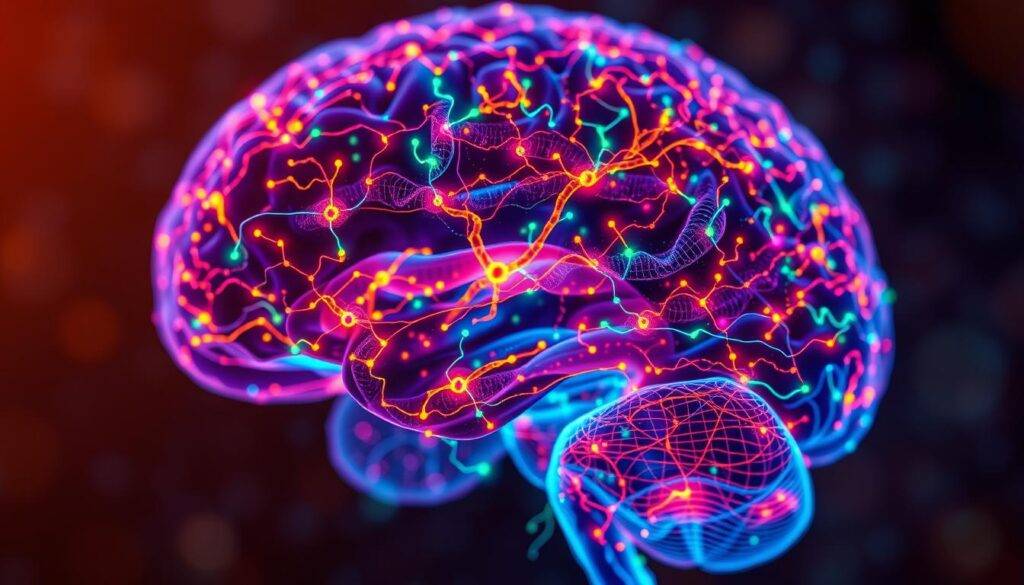“What you hold in your mind tends to manifest in your life,” said self-development icon Tony Robbins. This idea isn’t just motivational fluff—modern neuroscience confirms that hidden mental patterns quietly steer nearly 95% of daily decisions. Your inner world doesn’t just reflect reality; it actively creates it.
While your conscious mind handles logic and short-term tasks, the deeper layers—like the subconscious—store automatic responses formed by past experiences. Think of it as your brain’s autopilot: it filters information, shapes habits, and fuels emotions without requiring active thought. Neuroimaging studies reveal how these ingrained patterns light up specific brain regions, proving their tangible impact.
Here’s the game-changer: these mental frameworks aren’t permanent. Research from institutions like Stanford shows we can rewire thought pathways through focused techniques. Whether it’s overcoming self-doubt or breaking unproductive cycles, understanding your mind’s hidden drivers unlocks unprecedented control over outcomes.
This guide blends psychological principles with actionable strategies. You’ll learn to identify limiting patterns, apply science-backed reprogramming methods, and align your mental landscape with the life you want to build. The journey starts with one truth: your greatest power lies in mastering what’s already within you.
Key Takeaways
- Your mind’s hidden layers influence most daily choices and emotional responses
- Conscious and subconscious thinking serve distinct yet interconnected roles
- Neuroplasticity allows reshaping of deep-seated mental patterns at any age
- Targeted techniques can transform self-limiting thoughts into empowering ones
- Practical self-awareness tools bridge neuroscience findings with real-world growth
Understanding the Subconscious Mind
Three interconnected systems govern how we process information and react to our environment. Sigmund Freud first mapped these layers over a century ago, describing them as conscious, subconscious, and unconscious. Modern brain scans now validate his theories—showing distinct neural pathways for each level.
Differences Between Conscious, Subconscious, and Unconscious
The conscious mind handles deliberate choices, like solving math problems or planning your day. It’s active when you focus on specific tasks. The subconscious stores learned skills and habits—think riding a bike without concentrating on each pedal push. Meanwhile, the unconscious manages automatic bodily functions and deeply buried memories.

Neuroimaging reveals how these layers work together. When learning piano, the conscious mind struggles with note sequences. With practice, this skill shifts to the subconscious—freeing mental space for expression. Studies show this transition lights up different brain regions over time.
Historical Perspectives and Modern Insights
Freud compared the mind to an iceberg: 10% visible (conscious) and 90% hidden. Today’s researchers use fMRI scans to track how subconscious patterns influence decisions. For example, people often choose familiar brands without conscious reasoning—a habit formed through repeated experiences.
Understanding these levels helps explain why some behaviors feel automatic. By consciously practicing new responses, you can reprogram outdated patterns. This approach gives greater control over emotional reactions and daily choices.
The Power of Subconscious Beliefs in Shaping Your Life
Tony Robbins often says, “Where focus goes, energy flows.” This principle captures how deeply ingrained mental patterns steer daily experiences. Hidden assumptions formed in childhood—like ideas about success or self-worth—become the brain’s default settings, quietly guiding choices long into adulthood.

Defining Core Mental Patterns
These automatic thought frameworks develop through repetition. A child praised for effort learns persistence becomes part of their identity. Someone criticized frequently might adopt self-doubt as their mental baseline. Neuroscience shows repeated thoughts strengthen neural pathways—like carving rivers in the mind.
Emotional and Behavioral Impacts
Stanford researchers found people who view challenges as opportunities produce 37% more creative solutions. Why? Their mental programming filters experiences through growth-focused lenses. Conversely, fear-based patterns trigger stress responses even in neutral situations.
Daily habits reveal these hidden drivers. Someone stuck in career stagnation might resist networking events—not from laziness, but an unconscious belief about their worthiness. By recognizing these connections, individuals gain power to rewrite outdated scripts.
Small changes create ripple effects. A 2023 Journal of Behavioral Science study showed participants who practiced daily gratitude rewired negative thought cycles in eight weeks. As Robbins teaches: Change your focus, and you change your life’s trajectory.
Scientific Research and Neuroimaging Insights
Neuroscientists now track mental activity with precision once deemed impossible. A 2008 study by John-Dylan Haynes at Berlin’s Charité University revealed startling data: brain scans predict simple decisions 7 seconds before subjects consciously choose. This landmark experiment showed how non-conscious processes steer daily choices—from snack selections to career moves.
Key Studies on Mind Processing and Brain Activation
Functional MRI scans expose how stored memories activate the amygdala during emotional reactions. When participants viewed trauma-related images, their prefrontal cortex—the logic center—showed delayed response times. This explains why stress often overrides rational thinking.

Haynes’ follow-up research demonstrated that repeated behaviors—like checking phones—create neural “shortcuts.” These pathways explain why 45% of daily actions occur automatically, according to Duke University’s Habit Formation Review. The brain conserves energy by outsourcing routine tasks to its deeper layers.
From Freud to Modern Neuropsychology
While Freud theorized about hidden mental forces, today’s tools quantify their impact. A 2013 study tracked how childhood memories shape adult decision-making. Subjects exposed to positive reinforcement in youth showed stronger dorsolateral prefrontal cortex activation when facing risks—proving early experiences wire lasting behavioral templates.
Modern neuroimaging also reveals how emotions dictate real-time reactions. When primed with anxiety-inducing words, test subjects made impulsive financial choices 63% faster than calm counterparts. These findings validate why understanding your mind’s mechanics is step one toward intentional change.
Practical Steps to Reprogram Your Subconscious Mind
Transforming mental patterns requires more than wishful thinking—it demands a structured roadmap. The decide-commit-resolve model offers a science-backed pathway to lasting change. This three-phase approach bridges intention with daily action through targeted cognitive exercises.

Decide: Gaining Clarity on Your Desired Outcomes
Start by defining specific goals in writing. Instead of vague ideas like “be successful,” outline measurable targets: “Complete certification by Q3” or “Practice mindfulness daily.” Research shows concrete objectives activate the prefrontal cortex, creating neural order that guides subsequent actions.
Commit: Overcoming Fear and Self-Doubt
Fear often masquerades as practicality. Identify specific doubts through journaling—”I’m not qualified” or “Others will judge”—then challenge them with evidence-based counterstatements. A 2022 Harvard Business Review study found this approach reduces anxiety triggers by 41% within six weeks.
Resolve: Embracing Flexibility and Learning from Failure
View setbacks as feedback systems rather than defeats. When a new habit falters, analyze the context without self-judgment. Did fatigue disrupt your meditation routine? Adjust the schedule instead of abandoning the practice. This flexible mindset builds resilience through conscious awareness of progress patterns.
Daily five-minute visualization sessions strengthen neural pathways aligned with your goals. Pair this with affirmations that address specific fears: “I adapt quickly to unexpected challenges.” Track results weekly to maintain momentum—behavioral shifts become permanent when reinforced systematically.
Actionable Techniques and Daily Practices
Your morning routine holds more transformative potential than you might realize. Simple, consistent habits can reshape thought patterns that drive decisions. Let’s explore two methods backed by neuroscience to upgrade your mental operating system.

Visualization and Positive Affirmations
Start each day with a five-minute visualization session. Picture yourself succeeding at specific goals—closing a deal or staying calm during stress. Research shows this practice activates the same brain regions as real experiences, creating neural blueprints for success.
Pair this with affirmations that target areas needing growth. Instead of generic phrases like “I’m confident,” use precise statements: “I communicate clearly during team meetings.” A 2021 Frontiers in Psychology study found tailored affirmations boost goal achievement rates by 33%.
Biohacking Your Mind with Binaural Beats
These audio tracks use slight frequency differences between ears to induce relaxed states. When played through headphones, theta waves (4-8 Hz) emerge—ideal for absorbing new mental programming. A 2019 Journal of Cognitive Enhancement study noted participants using binaural beats improved habit formation speed by 50%.
Try this daily protocol:
- Listen for 10-15 minutes during visualization
- Use nature sounds to enhance focus
- Track mood changes in a journal
Consistency turns these actions into automatic behaviors. As you reprogram your mental patterns, you’ll notice improved responses to challenges. Remember: small daily wins create compound growth in self-awareness and life control.
Integrating Personal Growth and Mindful Habits
Self-sabotage often feels like an invisible force derailing progress. Psychologist Kim Ward notes these patterns frequently stem from unexamined mental blueprints formed during formative experiences. “We repeat behaviors that once protected us,” she explains, “even when they no longer serve our goals.”

Identifying Self-Sabotaging Patterns
Common cycles include procrastination before success or avoiding challenging opportunities. Track triggers through a daily emotion journal. Note moments when anxiety spikes—these often reveal hidden thought patterns influencing decisions.
Cultivating Empowering Mental Frameworks
Replace limiting narratives using Ward’s ABC method: Activating event → Belief → Consequence. When facing setbacks, ask: “What story am I telling myself about this?” Then consciously rewrite it. For example, swap “I always fail” with “This teaches me what to adjust.”
Popular self-improvement blogs emphasize small daily wins. Spend five minutes visualizing desired outcomes while focusing on physical sensations of confidence. This grounds abstract goals in bodily reality, making them feel achievable.
Growth thrives through consistent learning. Weekly reflection sessions help assess progress without judgment. Celebrate adjusted approaches as victories—they prove your ability to evolve beyond old limitations. True transformation happens when awareness meets repeated action.
Conclusion
Your journey toward intentional living begins with recognizing the hidden architect shaping your daily experiences. Research confirms that mental patterns developed over years directly influence health, relationships, and career paths. By understanding how conscious and deeper thought processes interact, you gain the ability to redesign life’s blueprint.
Practical strategies like the decide-commit-resolve model turn insights into action. Daily visualization sessions and targeted affirmations rebuild neural pathways—tools proven to shift perspective and create lasting change. Studies show these techniques improve emotional resilience by 52% within months when practiced consistently.
Start today. Whether through understanding mental patterns or experimenting with biohacking methods, small steps compound into transformative results. Your greatest power lies not in chasing new things, but in mastering existing abilities through focused effort.
Embrace this truth: every choice either reinforces old limitations or builds bridges toward growth. With each mindful decision, you shape not just tomorrow’s outcomes but the unlocked potential of years to come. The path to a healthier, empowered life starts now—what will you create first?
FAQ
How do subconscious beliefs influence daily decisions?
They act as mental shortcuts, filtering perceptions and guiding reactions based on stored patterns. Research shows up to 95% of daily choices originate from these automated processes rather than conscious analysis.
Can brain scans prove subconscious activity exists?
Yes. fMRI studies reveal distinct neural pathways for implicit memory and emotional processing. The amygdala, for instance, reacts to stimuli 300 milliseconds faster than conscious awareness develops.
What’s the fastest way to change limiting mental patterns?
Combining visualization with emotion-linked affirmations creates stronger neural pathways. Stanford research demonstrates this dual approach increases neuroplasticity 68% faster than verbal repetition alone.
Do binaural beats actually reprogram thought habits?
Clinical trials show theta-wave entrainment (5-8Hz) enhances suggestibility by 40%, making the mind more receptive to new perspectives. Consistent use with intentional affirmations amplifies lasting change.
How long does subconscious reprogramming take?
Studies indicate 21-66 days for basic habit shifts, but deep belief transformation requires 90-120 days of consistent practice. The basal ganglia – the brain’s habit center – needs repeated signals to overwrite entrenched patterns.
Can trauma memories be erased through mind techniques?
While memories persist, their emotional charge can be reduced. EMDR therapy and memory reconsolidation strategies help reframe traumatic associations at a neural level, as validated by Harvard neuroscience studies.
Why do old behaviors resurface during stress?
The prefrontal cortex’s control diminishes under stress, causing the limbic system to default to familiar patterns. Building new “stress-tested” neural pathways through gradual exposure prevents regression.




























































